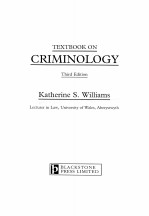

Textbook on CriminologyPDF电子书下载
- 电子书积分:17 积分如何计算积分?
- 作 者:Williams
- 出 版 社:Blackstone Press [Imprint];Oxford University Press
- 出版年份:1998
- ISBN:9781854316929;1854316923
- 页数:563 页
1 Introduction 1
2 Definitions, Terminology and the Criminal Process 6
2.1 Introduction 6
2.2 The judicial process 2
2.3 Formal sources of criminal law 7
2.4 Underlying influences 7
2.5 Defining a crime 11
2.6 Enforcement of criminal laws 29
2.7 The criminal 37
2.8 Terminology and classification 38
2.9 Appeals 39
2.10 Limits of prosecution 40
2.11 Evi-dence 42
2.12 Punishment 42
3 Public Conceptions and Misconceptions of Crime 46
3.1 Introduction 46
3.2 Popular and media perceptions of crime 47
3.3 Effects of media on public perceptions of crime 55
3.4 Two unperceived areas of crime 60
4 The Extent of Crime:A Comparison of Official and Unofficial Calculations 76
4.1 Official statistics 76
4.2 Comparative problems with official statistics 81
4.3 The dark figure of crime 83
4.4 Conclusion 95
5 Victims, Victimisations and Victimology 98
5.1 Introduction 98
5.2 Theextent of the problem 102
5.3 Who is at risk and why? 104
5.4 Who fears crime? 111
5.5 Support and services for victims 114
5.6 Victim precipitation and lifestyle 126
5.7 Conclusion 130
6 Influences of Physical Factors and Genetics on Criminality 140
6.1 Introduction 140
6.2 Early constitutional or biological theories 141
6.3 Lombroso 142
6.4 After Lombroso 145
6.5 Somatotypes and criminality 148
6.6 Genetic factors 149
6.7 Conclusion 163
7 Influences of Biochemical Factors and of the Central and Autonomic Nervous Systems on Criminality 168
7.1 Biochemical factors 168
7.2 Nutritionally induced biochemical imbalances 177
7.3 Criminality and the central nervous system 182
7.4 Criminality and the autonomic nervous system 187
7.5 Conclusion 189
7.6 Postscript on biology and crime 192
8 Psychological Theories of Criminality 197
8.1 Introduction 197
8.2 Psychoanalysis and criminality 198
8.3 The normal criminal personality 206
8.4 Assessment of dangerousness and criminality 219
8.5 Conclusions 234
9 Mental Disorder and Criminality 240
9.1 Introduction 240
9.2 Legal ideas of mental disorder 241
9.3 Medical ideas of mental illness 250
9.4 Psychopathy 256
9.5 Self-induced mental incapacity 259
9.6 Conclusion 266
10 Intelligence and Learning 272
10.1 Intelligence and crime 272
10.2 Learning 283
10.3 Conclusion 298
11 The Sociology of Criminality 305
11.1 Introduction 305
11.2 The ecology of crime 309
11.3 Poverty and unem-ployment 324
11.4 Lower-class culture 329
11.5 Conclusion 335
12 Anomie, Strain and Juvenile Subculture 343
12.1 Anomie and criminality 343
12.2 Strain and relative deprivation 351
12.3 Subcultural theories of juvenile deviance 354
12.4 Matza and Sykes 362
12.5 Conclusion 366
13 Control Theories 370
13.1 Introduction 370
13.2 Early control theories 371
13.3 Individual control 372
13.4 Sociological control theories 376
13.5 Control balance 379
13.6 Facilitat-ing and choosing criminality 382
13.7 Community based origins of conformity 383
13.8 Official or institutional control agents 393
13.9 Evaluation of control theories 402
14 Labelling, Phenomenology and Ethnomethodology 411
14.1 Introduction 411
14.2 Labelling or interactionism 413
14.3 Phenomen-ology and ethnomethodology 425
14.4 Left idealism 432
15 Conflict Theories and Radical Criminologies 438
15.1 Introduction 438
15.2 Conflict theories 439
15.3 Radical criminology 453
15.4 Conclusion 457
16 Criminology and Realism 462
16.1 The birth of realism 462
16.2 Right realism 464
16.3 Left realism 469
17 Positivist Explanations of Female Criminality 490
17.1 Introduction 490
17.2 Biological, hormonal and psychological theories 491
17.3 Learning theories 503
17.4 Sex role theories 504
17.5 Strain theories 508
17.6 Control theories 509
17.7 Conclusion 511
18 Women's Liberation and Feminist Theories 516
18.1 Introduction 516
18.2 Female liberation 517
18.3 Feminist theories 526
18.4 Conclusion 535
19 Envoi 541
Index 545
- 《新时代商务英语综合教程 教师用书 1》王立非总主编;孔宪遂主编;丁芬,阮岳湘,张斐瑞副主编;王海萍,王莹,金红卫编著;(英)LAN WOOD,ANNE WILLIAMS原著作者 2019
- 《商务与经济统计 原书第11版》(美)戴维 R. 安德森(DAVID R.ANDERSON),丹尼斯 J. 斯威尼(DENNIS J. SWEENEY),托马斯 A.威廉斯(THOMAS A.WILLIAMS)著 2013
- 《中国总论 卷1 上》张西平,吴志良,陶德民丛书主编;(美)卫三畏(Samuel Wells Williams)著 2013
- 《管理在管什么 管人 管作业 管资讯 管资源》Kate Williams & Bob Johnson著;高子梅译 2010
- 《英语教师用书 八年级 下 第14册 第3版》王蔷,Ivor Williams,Jaime Antonio Solis主编 2006
- 《英语 第12册 七年级下学期用》王蔷,Ivor Williams,Jaime Antonio Solis主编;俞唐,曹瑞珍副主编 2006
- 《中国总论 卷2 下》张西平,吴志良,陶德民丛书主编;(美)卫三畏(Samuel Wells Williams)著 2013
- 《英语 第14册 八年级下学期用》王蔷,Ivor Williams,Jaime Antonio Solis主编;俞唐,曹瑞珍副主编 2006
- 《中国总论 卷1 下》张西平,吴志良,陶德民丛书主编;(美)卫三畏(Samuel Wells Williams)著 2013
- 《中国总论 卷2 上》张西平,吴志良,陶德民丛书主编;(美)卫三畏(Samuel Wells Williams)著 2013
- 《竞争战略 全译珍藏版》(美)迈克尔·波特(Michael E. Porter)著 2012
- 《网络互联技术手册 第2版》(美)(K.唐斯)Kevin Downes等著;包晓露等译 1999
- 《新版交换式以太网和快速型以太网 第2版》(美)(R.布雷耶)Robert Breyer,(美)(S.赖利)Sean Riley著;肖文贵等译 1997
- 《摄影100关键词》(英)克拉克著 2011
- 《守望百年 中英文对照爱情长诗》蔡丽双著;张智中译 2014
- 《环境政策概要》(英)卡罗琳·斯奈尔(Carolyn Snell)著;宋伟译 2017
- 《驼铃 中-英-波兰文对照诗集》蔡丽双著;张智中,(波兰)博古米娜·雅尼卡译 2015
- 《爱海情帆 中-英-罗马尼亚文对照爱情长诗》蔡丽双著;张智中,德拉戈斯·巴尔布译 2016
- 《准备,开始,哎哟》(美)弗兰·马努斯肯著;(美)黛安娜·帕尔米西若绘;魏亚西译 2014
- 《埋藏在后院》(美)盖尔·赫尔曼著;(美)杰里·斯马斯绘;筱舟译 2014
